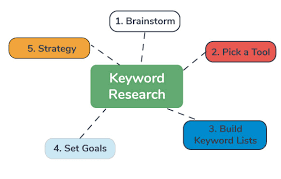
Keyword research is a fundamental aspect of SEO that helps you discover what your target audience is searching for. By identifying and optimizing for the right keywords, you can increase organic traffic and improve search rankings. Follow this step-by-step guide to conduct keyword research like a pro.
Step 1: Understand Your Niche
Before diving into keyword research, it’s essential to understand your niche and target audience. Ask yourself:
What topics are relevant to my business?
What problems does my audience need solutions for?
Who are my competitors, and what keywords are they targeting?
Step 2: Brainstorm Seed Keywords
Seed keywords are the foundation of keyword research. These are broad terms related to your business or industry. For example, if you own a fitness blog, seed keywords might include “weight loss,” “home workouts,” or “healthy eating.”
Step 3: Use Keyword Research Tools
Leverage keyword research tools to expand your list of potential keywords. Some popular tools include:
Google Keyword Planner – Great for finding search volume and competition level.
Ahrefs – Provides keyword difficulty, search intent, and competitor analysis.
SEMrush – Helps with keyword discovery and competitive analysis.
Ubersuggest – Free tool offering keyword ideas and search volume.
Step 4: Analyze Search Intent
Understanding search intent is crucial for selecting the right keywords. Search intent can be categorized into four types:
Informational – Users are looking for knowledge (e.g., “how to do keyword research”).
Navigational – Users want to find a specific website (e.g., “Google Keyword Planner”).
Transactional – Users intend to make a purchase (e.g., “buy running shoes online”).
Commercial Investigation – Users are comparing options (e.g., “best SEO tools 2025”).
Step 5: Evaluate Keyword Metrics
Not all keywords are worth targeting. Consider these key metrics:
Search Volume – How often is the keyword searched?
Keyword Difficulty – How hard is it to rank for the keyword?
Cost-Per-Click (CPC) – Indicates competition level in paid search.
Trends – Use Google Trends to see if the keyword’s popularity is growing.
Step 6: Find Long-Tail Keywords
Long-tail keywords are more specific phrases with lower competition but higher conversion potential. Example:
Short-tail: “SEO tips”
Long-tail: “best SEO tips for small businesses in 2025”
Step 7: Analyze Competitor Keywords
Study what keywords your competitors are ranking for using tools like Ahrefs or SEMrush. Look for gaps where you can create better content and outrank them.
Step 8: Organize and Prioritize Keywords
Once you have a list of potential keywords, categorize them based on:
Primary Keywords – Core keywords that define your content.
Secondary Keywords – Supporting keywords that add context.
LSI Keywords – Related terms that improve content relevance.
Step 9: Create High-Quality Content Around Keywords
Having the right keywords is only useful if you create valuable content around them. Ensure your content:
Matches search intent
Is well-structured with headings and subheadings
Includes internal and external links
Provides unique insights and solutions
Step 10: Track Performance and Adjust
SEO is an ongoing process. Monitor keyword performance using Google Search Console and Google Analytics. Adjust your strategy based on:
Keyword rankings
Click-through rate (CTR)
Bounce rate
Conversion metrics
Conclusion
Keyword research is a crucial step in any SEO strategy. By following this step-by-step guide, you can discover high-value keywords, create targeted content, and drive more organic traffic to your website. Stay updated with trends and continuously refine your keyword strategy for long-term success.







